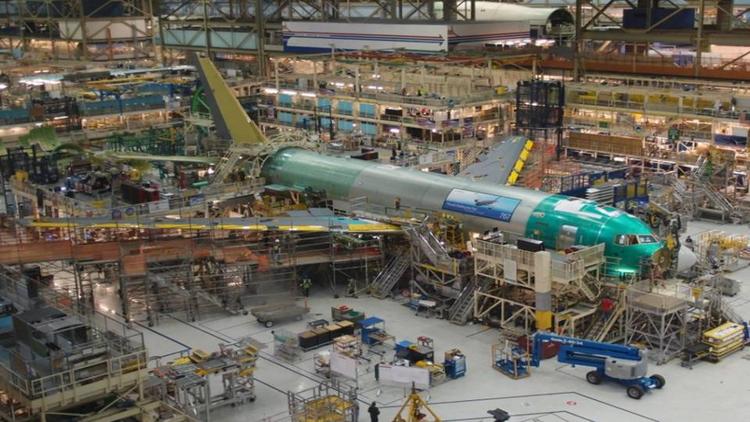
KC-46 on Boeing factory floor
UPDATED: To include response of Republican Rep. Rob Wittman, ranking member of House Seapower and Projection Forces subcommitee.
WASHINGTON: UPDATE BEGINS. Republican Rep. Rob Wittman, ranking member of the House Armed Services subcommittee with oversight power for the air mobility, this evening blasted the new deal between Air Force and Boeing for fixes to the troubled KC-46 tanker’s boom control cameras.
The Air Force “continues to accept the KC-46A tanker aircraft that cannot deliver fuel and cannot even hold fuel—the very purpose of a tanker. And now, Air Force announces today that they will pay full price to the prime contractor for all of these deficient aircraft,” Wittman said.
The Air Force, he added, “has been significantly damaged by the contractor’s inability to provide an operational aircraft. This is unacceptable and a misuse of tax-payer dollars. I believe we should reduce the KC-46A authorization to the minimally sustained level of 12 aircraft until the contractor can deliver an operational aircraft. Additionally, we should keep legacy aircraft longer to fill the operational gap. Defense contractors should not be rewarded for their poor performance.”
Wittman is among a number of members on both sides of Capitol Hill who have been questioning the Air Forces plan to retire older KC-135 and KC-10 tankers before the KC-46 is fully operational. UPDATE ENDS.
The Air Force and Boeing this afternoon signed a deal to fix the troubled KC-46 tanker’s boom control cameras, called the Remote Visual System (RVS), Air Force acquisition chief Will Roper said.
The Air Force will release some $882 million in cash it has withheld from Boeing due to deficiencies outstanding on the 33 aircraft that have been delivered, Roper told reporters in a Zoom meeting — the first his office has tried. Roper said release was, in part, spurred by concerns about Boeing’s corporate health, as well as that of its subcontractors, because of the COVID-19 coronavirus pandemic. That agreement is separate from the deal on the RVS system.
Roper stressed that, as the Air Force reviews all Boeing’s corrections to the 159 outstanding deficiencies with the current KC-46 design over the next 120 days, if any are not satisfactory, the service will begin withholding money again.
Roper told reporters the agreement includes “a major overhaul” of the RVS’s current cameras and sensors, as well as the cockpit displays and internal software. Calling the new system “RVS 2.0,” Roper said the new system will add a light detection and ranging (LIDAR) system that will help boom operators better see the position of the boom and the client aircraft during airborne re-fueling operations.
“What’s really cool … is a proper RVS like that is right on the doorsteps of autonomy,” he said. “All you have to do is take that data that tells the world inside the jet the reality of geometry between the airplane and the boom outside the jet, and once you have that, translate it into algorithms that allow the tanker to tank itself.”
Jamie Burgess, Boeing VP and program manager for KC-46, told reporters this evening that the new technology being designed by Boeing for RVS 2.0 will serve as “an enabler” for future drone tankers. He explained that the company and the Air Force are partnering on how to go forward toward that goal, but no monetary agreements have yet been struck.
Burgess confirmed, however, that Boeing is paying for a series of interim software and hardware upgrades to the current RVS design, as well as all the new technology for the next-generation RVS 2.0.
Boeing expects to being flight tests of the the interim enhancements “early this summer,” and begin fielding by the second half of 2021, he said. “For the complete technology refresh, we will begin flight testing in the 2022 time frame and be ready for fielding in the second half of 2023,” he added. “It’s a two-phased approach.”
The key problem with the current RVS — that Roper calls RVS 1.0 — is that the images taken become distorted in a manner that could led to boom crashing into the client aircraft during refueling in some lighting conditions.The aircraft lacks a window for boom operators to help steer the boom.
Roper said the current RVS is based on “a fundamental design flaw.”
Air Force Chief of Staff Gen. David Goldfein told reporters yesterday that the two sides were in final negotiations, and the agreement was first reported by colleague Valerie Insinna earlier today.
RVS is only the most troubling Category 1 deficiency afflicting the KC-46. A few days ago the Air Force identified leaks in the tanker’s fuel lines as a Category 1 deficiency, the fifth Category 1 the supposedly low-risk KC-46 program has racked up.
Goldfein yesterday said yesterday the fuel line issue should not result in yet another delay to delivery of the tanker. Roper echoed Goldfein’s optimism, noting that Boeing already has integrated fixes to seven aircraft. He explained the problem involved improper fitting of flexible valves in the line, allowing slow-motion leaks. While not necessarily life threatening, the leaks would be a major problem over time if not corrected.
Boeing originally promised to deliver 18 combat-ready aircraft in 2017, but a cascade of problems has set that back. The first plane was delivered in January 2019, but then the discovery of Foreign Object Debris (FOD) in a range of places and a number of aircraft caused the Air Force to temporarily halt delivery last February. Boeing has already paid $3.5 billion out of its own pocket to in cost overruns.
“This program has a lot of baggage,” Roper said somewhat wryly. But, he added, “I feel a lot better now about the RVA, and feel we have a trajectory that is going to lead us to success.”
Sullivan: Defense industry ‘still underestimating’ global need for munitions
National Security Advisor Jake Sullivan said that there are “no plans” for another Ukraine supplemental at this point.


























